Round 1 of the Classic Quarter League Qualifier Tournament #3 is now underway. While Wizards has announced that Vintage will eventually make its way to Magic Online, there is still a lot of Classic left to be played before the curtain is dropped and the lights go out. It’s my goal to make sure that Classic goes out with a bang. The Invitational will hopefully allow Classic to ride off into the sunset.
Since the announcement from Wizards to eventually bring Vintage online, the format has been a bit stagnant. Daily Events have not fired at all aside from one rogue event at the very end of what is most people’s New Year’s vacation. Finding matches in the Tournament Practice room is hit or miss, which makes preparing for such a large and significant tournament that much more daunting. This is why I’d like to share my personal experience and take you through the trials and tribulations of my testing for QT #3.
First Take
At first I wanted to try to do something that I thought was completely different. PlanetWalls has found some success in the first two QTs by looking at completely ignored cards to attack the format. In QT #1, he played an innovative Birthing Pod combo deck that no one was prepared for. Frost Titan was his finisher in QT #2 and it was important because of how difficult it was to remove once it hit the board.
My previous endeavors of trying to play a rogue deck had not been quite as successful, but I wanted to give it the old “College Try” anyway. I had started my planning about 3 weeks in advance, so there was plenty of time to audible to another more proven deck if things didn’t work out.
Piggybacking on PlanetWalls’ innovation of Frost Titan, I wanted to see if there was any way to take it a step further and abuse the following cards:
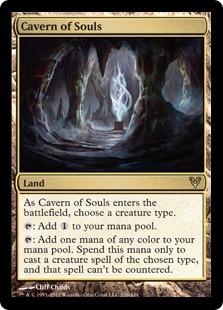
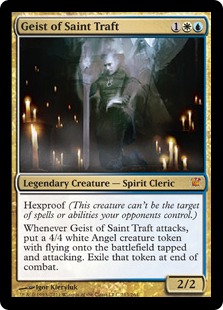
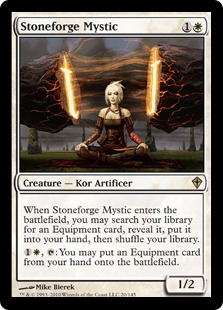
While there aren’t any overlapping synergies between all three, having just a single Cavern in the opening hand would be flexible enough to drop an early uncounterable threat that could take over the game. My idea was basically this: build a control deck around these 2 creatures and make them uncounterable with Cavern. The fact that Geist, like Frost Titan, is impossible to get off the board once he is played, makes him a serious threat. Phyrexian Metamorph and the rare Pyroclasm effect are perhaps the only relevant cards that can do anything against Geist. Here is the list I had been testing before ultimately giving up on the deck for QT #3:
UW Geist Blade by enderfall
|
| ||||||||
The deck had a lot of things going for it beyond the 3-card shell outlined above. Going into the testing process, I was very concerned about Abrupt Decay, and when looking through the available options, I stumbled upon Misdirection. My theory was that if I can’t counter Decay, I might was well try to derive some value out of it. Just about every single deck that uses Decay will have a 3-or-less casting cost card on the battlefield to which to redirect it. Against all the other Blue-based Control decks that don’t use decay, Misdirection was at least a “free” piece of hard countermagic that could help win a counter war. The sideboard was also filled with some nice tech in the form of Terminus for the creature and Affinity matchups.
In the end, I was unable to give this deck the proper testing gauntlet that it deserved. I still feel that there is something there that can be built upon, but after a couple weeks of (minimal) testing, I just wasn’t happy with how fast I was going to be able to make changes with roughly 8-9 days left before QT #3 started.
If I were to more seriously look at improving the deck, I would start by adding more Geists, possibly up to a total of 4. I would also see if other Hexproof creatures could fit the bill, even if it meant adding another color like green to add something like Thrun, the Last Troll or even Nimble Mongoose. It could also be that Stoneforge Mystic is not the card that this deck wants, especially if Abrupt Decay remains a commonly played card in the format.
Second Take
Needing to quickly change gears, but not reinvent the wheel, I looked at some of the already established decks and tried to see if there was anything I really felt was worthwhile to play. Without having qualified for the Invitational yet, and with only 2 more chances, I didn’t want to mess around with something I had not played enough times to feel comfortable with.
One of the first things I wanted to identify was what people generally consider the best and most powerful decks in order to try and power my way into an invite. A lot of this was gut feeling rather than any sort of tangible proof, but I figured that the most powerful decks were going to be (in no particular order): Affinity, Oath, and Workshop decks. While it may not seem like much of a revelation to say that these 3 decks were at the top of the metagame, it does indicate where people would be looking to start when making their own considerations for what deck they would choose to play.
When thinking of these 3 top decks, I kept thinking back to what made PlanetWalls so successful. Many people will say that the omnipresence of these 3 decks led to the format being a bit stagnant. I still wanted to disprove this in my last bit of testing.
So there I was again, trying to build something rogue. I couldn’t help but have the feeling that innovation was still possible even if the odds were stacked up against it. Yes, Affinity is incredibly fast and Workshop decks can lock you down before you get a chance to get started, but there is room to innovate within those parameters. Attacking similarities between those two decks is a great place to start. There was one card that I wanted to try and abuse to great effect against both of these decks and a card that many people may have forgotten even existed in a format devoid of Power:
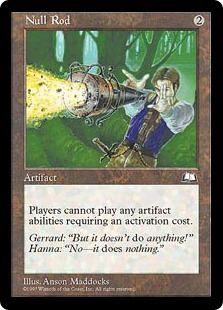
Null Rod has been a staple of Fish decks in vintage for many years. It single-handily allows the disruptive and efficient creatures to be able to compete in Vintage. In Classic, however, its use is a little narrower. There are lots of artifacts that Null Rod can shut down. Lotus Petal, Time Vault, Sol Ring, etc., but nothing that would sway the odds dramatically back towards your favor. What attracted me to Null Rod was its applications in fighting off the key cards in Affinity and Workshops, namely:
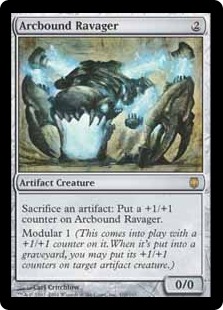
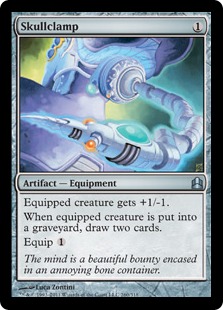
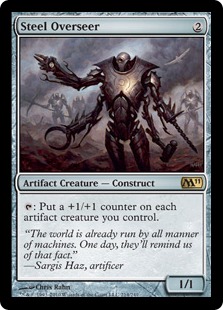
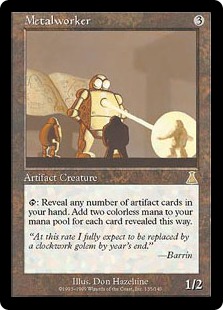
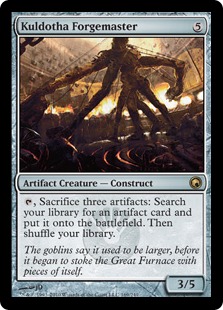
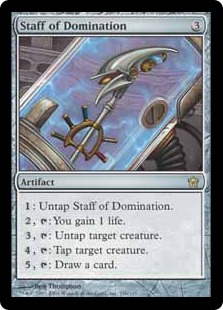
Shutting off these cards will either completely bottle up your opponent or buy you valuable turns to establish your own game plan. The problem with Null Rod is twofold: 1. You need to get Null Rod onto the table as fast as possible, often on Turn 1 if able, and 2. Building your deck so that Null Rod doesn’t handcuff your own cards.
Problem #1 relates to which decks would be best-served to utilize Null Rod. Getting it out on Turn 1 is not practical in most Fish decks. It would normally require the use of your own artifact acceleration, which Null Rod would in turn shut down. Elvish Spirit Guide is a possibility, except that your deck would be drawing 3 mana vanilla 2/2s late in the game. The best way to get Null Rod out on Turn 1 without the use of artifact acceleration is by using “Sol Lands” (Ancient Tomb and City of Traitors) or Mishra’s Workshop itself. Yes, the card that powers both of the decks that I was aiming to beat also provided the best platform with which to nullify my opponent’s decks.
The reason we need Null Rod out on Turn 1 is if we lose the die roll, a Turn 1 Skullclamp (or a whole host of other cards) from Affinity as well as a Turn 1 Metalworker from Workshop decks have to be stopped before the game gets out of hand. With this in mind, I sleeved up a deck that started out very similar to the one below:
First Draft Null Rod Shop by enderfall
|
| ||||||||
The first build was based off a build from a couple years back that I believe Whiffy Penguin made. The initial build was all-in on the “Don’t Let Your Own Null Rod Beat You” Plan with a side of “Get Wurmcoil Engine Into Play ASAP”. I quickly found that that wasn’t enough.
With the help of Workshop expert Montolio, we were able to analyze the weakness my deck had, which was that it was just a turn or two too slow. Artifact mana acceleration was necessary to be more explosive in the games where Null Rod was either not available on Turn 1 or 2, or was completely useless in the matchup. Sol Ring and Mana Crypt were added at the expense of some non-land cards.
Another area that needed some change was the maindeck ratio of Rods. In matchups where Rod was not necessary, having 3 in the maindeck would be overkill. A 2/1 split with the board was a better way to deal with pre-board games. In place of a Rod, a 4th Phyrexian Revoker was added due to its flexibility. It can shut off many of those same problem cards that Rod can as well as others that Rod can’t touch, specifically planeswalkers, and it can even attack them in a pinch.
Some other tweaks were made, such as adding a pair of Rishadan Ports and some changes on the back-end of the curve; adding Duplicant and a Precursor Golem.
The sideboard was tweaked to cater to the expected field. The aforementioned Null Rod was joined by a suite of cards designed to deal with 3 matchups: Oath, Dredge, and the mirror. Witchbane Orb was some last minute tech I started tinkering with to fight off Abrupt Decay, which more and more Oath decks had adopted to hate out Grafdigger’s cage (of which I had the full set of 4). It also has some collateral damage against Storm players, and in the event someone played other combo decks trying to strip key cards from your hand.
The final deck looked like this:
Final Null Rod Shop by enderfall
|
| ||||||||
I was prepared to play this deck and had even saved it as a .txt file to upload to Gatherling.com to register. Late Saturday evening, right before the deck submission deadline and at the same time I was about to log into Gatherling, Montolio sent me a PM on MTGO asking to play a quick match. Because Montolio was so instrumental in helping me come up with my final Null Rod list, I didn’t want to play it against him. I decided to play my UBr Turbo Tezz deck that I’ve had built for ages. It’s a fun deck and one that I wanted to try out one final time before I officially committed to playing Null Rod Shops. Here is the deck for reference:
Turbo Tezz 2.0 by enderfall
|
| ||||||||
Montolio played his GWB aggro-control Fish deck that he had been heavily testing (and eventually chose to not play in the QT). It was clearly tuned since he last piloted the deck in QT #2 to a Top 8 birth.
The exact details of the games weren’t too important. I recall getting down a Tezzeret, Agent of Bolas and a Myr Battlesphere in Game 1 and was able to pull it out (despite a Swords to Plowshares that immediately hit the “BattleBall”) by converting 2 of the 1/1 Myr tokens into 5/5 behemoths. Game 2 was marked by a Turn 2 Knight of the Reliquary that, with the help of a fetch land and a Strip Mine, was immediately a 4/4 and out of range of my removal. Game 3 is where I had a last-minute epiphany…
Last-Minute Audible
Neither myself nor Montolio got off to a blazing start, and the game was still up for grabs in the middle turns. I was sandbagging a pair of Mana Drains and sitting pretty. That was until Montolio played this guy:
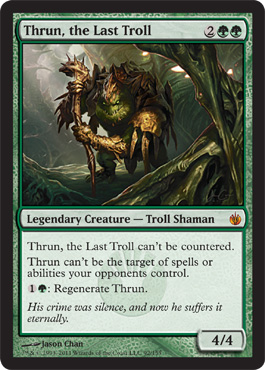
The game was effectively over at that point. There wasn’t anything that my deck could do to deal with Thrun. I conceded and quickly loaded up the BUG Control deck that I had built earlier this year.
If you recall, I found that Thrun was very powerful in Classic. Like Geist, there was really only one card that could deal with it once it hit the board: Metamorph. Where it really shines is that it doesn’t require Cavern of Souls to be uncounterable. Since I could hardly remember if I had ever lost a game in which I cast Thrun, KI figured that if one were good, two would be better!
Since I had been playing with the BUG deck off and on in the Tournament Practice Room over the last couple of months, I was very comfortable with the deck. Being able to play with Deathrite Shaman, Abrupt Decay, and Snapcaster Mage is where I truly should have been all along. Perhaps the most important card though was making sure that I had access to Force of Will (and a lesser extent Mental Misstep). Classic is still a format of broken things and having a fail-safe measure such as Force is much more comforting than trying to run out a bunch of Spheres and hoping to prevent your opponent from doing anything.
Here is the deck that I ultimately submitted:
BUG Midrange Control by enderfall
|
| ||||||||
I did make some changes since I last showcased the deck. As mentioned above, I upped the Thrun total to two, but I also added a few other creatures that I thought might be good in the metagame. Trygon Predator was added to take on the Oath decks and deal with artifact decks. Vendilion Clique was added to provide a flyer to block a Signal Pest and to disrupt opponents’ hands. Venser, Shaper Savant was added to deal with Oath and Tinker-bots. Venser also passes the Abrupt Decay Test. Finally, I added a single Stifle (thanks to PlanetWalls for that brilliant idea) so that opponents would need to stay honest since decklists are public.
With only a few minutes to spare before the deadline, I took a look at my new mana curve and realized that Dark Confidant, for as good as he is, probably isn’t the right fit for the deck. I spent some time looking through possible replacement cards and Baleful Strix quickly jumped out at me. While the casting cost might be prohibitive from playing it on Turn 2 100% of the time, the deck does have many mana fixing solutions available in Mox Diamond and Deathrite. It also draws a card immediately, doesn’t hurt my life total, and trades with every single creature in the format not named Blightsteel Colossus. Strix can also be pitched to a Force, unlike Confidant.
I then tweaked the sideboard to make sure that Dredge and Workshop decks would not run me over (sadly, Dredge is practically non-existent in this field with only 2 players piloting the deck). Originally, I had Energy Flux in the board to deal with artifact decks, but by adding Strix, that wasn’t the best card for the job anymore. Hurkyl’s Recall was the only sensible solution.
You’ll also notice the singleton Karakas in the board. I really wanted to play it in the maindeck as a Game 1 answer to Oath decks, but also due to its synergy with all of my legendary creatures. In the end, because it could not be used to cast any cards in my deck, it would have to replace a spell, and I just didn’t have the time to test which card could be expendable. I threw it in the board as yet another anti-Oath card, but I could end up brining it in against other matchups in a pinch, utilizing the aforementioned synergy.
The Proof is in the Pudding
I feel good about my deck choice and how I got to this point with my testing. Against the field, I believe there is a good chance that I can be successful with this deck,
The final tally for the metagame is as follows:
5 Oath
4 Workshops
3 Affinity
3 Delver
3 BUG
3 Flashing Rectum/2-Card Monte Combo
2 Helmline/Rest In Peace Combo
2 GWB hate
2 UW Control
2 Dredge
1 Burning Oath Combo
1 UGB Fish
1 Show and Tell/Omniscience Combo
1 Slivers
1 Merfolk
1 Infect Combo
1 Baleful Tezz
1 Welder Shops
1 Belcher
1 Rogue Hermit
1 Nivmagus Combo
Yet again, another wildly varied metagame. Makes me glad that I decided to play Force of Will with so many combo decks running around. Clanmates Cronin and abstrakt66 built a new combo deck around Flash and Academy Rector to cheat out an Omniscience so that they can hardcast Emrakul, the Aeons Torn. The deck can also combo into other broken things, but the star of the deck is Flashing Rector out. I’m eager to see how they perform and hopefully, I can avoid playing them. [Editor’s Note: Or you can just Stifle the Rector graveyard trigger. –Planetwalls]
There are some new faces in the field, which is always a welcome sight. If anyone was unable to play in this QT, the 4th and final QT leading up to the Invitational will start approximately May 27th. Best of luck to everyone in the tournament!
enderfall
Clan Magic Eternal
Follow me on Twitter @enderfall


I love watching workshop, do you feel like doing some videos for those of us who can’t afford vintage
@burt – That’s a great idea. I’ll try to get in an actual DE with a Workshop deck, but if not, I’ll try to round up some players for a “mock DE”.